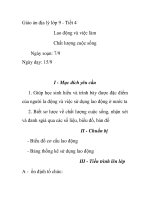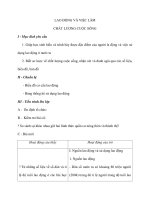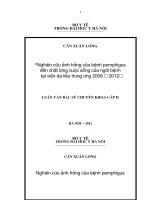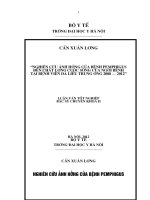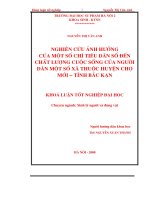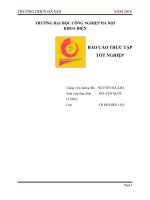Ảnh hưởng của mãn kinh và HRT đến chất lượng cuộc sống của phụ nữ_Tiếng Anh
Bạn đang xem bản rút gọn của tài liệu. Xem và tải ngay bản đầy đủ của tài liệu tại đây (1.2 MB, 45 trang )
<span class='text_page_counter'>(1)</span><div class='page_container' data-page=1>
Effects of menopause and hormone replacement
therapy (HRT) on quality of life of women
<i>MD. Nguyen Thi Ngoc Phuong </i>
<i>President of the Ho Chi Minh City Reproductive Endocrinology and </i>
<i>Infertility Association </i>
</div>
<span class='text_page_counter'>(2)</span><div class='page_container' data-page=2>
Most natural menopause occurs in elderly women
(48-52), so there are confused manifestations of
aging.
Early menopause due to premature ovarian failure
Before the age of 40 years
May be due to ovarian resection, chemotherapy,
radiation therapy: sudden
Or due to low oocyte reserve, for example Turner
syndrome 45, XO ...
</div>
<span class='text_page_counter'>(3)</span><div class='page_container' data-page=3>
Sexual hormones stimulate the central nervous
system to synthesize
<i><b>endogenous opioids: </b></i>
Endorphins, Enkephalins, Dynorphins.
</div>
<span class='text_page_counter'>(4)</span><div class='page_container' data-page=4>
<b>Estrogen and cardiovascular disease </b>
Young women seem to be protected from
cardiovascular disease
Menopause and old age are high risk factors
for cardiovascular disease.
Each organ contains stem cells, which help the
body to repair its own lesions, such as
fractures and soft part wounds…
<i> Doris A. Taylor et al. Texas Heart Institute at St. Luke’s </i>
</div>
<span class='text_page_counter'>(5)</span><div class='page_container' data-page=5>
Estrogen and cardiovascular disease
<b>CD34</b>
is the stem cell that circulates in the blood,
in the presence of
<b>Estrogens. </b>
<b>Tuổi già:</b>
decreased CD34, increased inflammatory
cytokines, increased monocytes.
<b>CD34 protects blood vessels:</b>
Injection of CD34
into atherosclerotic blood vessels of rats showed
decreased embolism, decreased apoptosis, decreased
inflammatory cytokines, increased vascular
endothelial growth factor (VEGF)
<i> Doris A. Taylor et al. Texas Heart Institute at St. Luke’s Episcopal </i>
</div>
<span class='text_page_counter'>(6)</span><div class='page_container' data-page=6>
Level I prophylaxis for cardiovascular
disease by hormone replacement therapy
1<sub>Salpeter S, et al. </sub><i><sub>J Gen Intern Med </sub></i><sub>2004;19:791-804. </sub>
2<sub>Salpeter S, et al. </sub><i><sub>J Gen Intern Med </sub></i><sub>2006;21:363-366. </sub>
3<sub>Walsh JME, et al. </sub><i><sub>JAMA</sub></i><sub> 2004;21:363-366. </sub>
4<sub>Ridker PM, et al. </sub><i><sub>N Engl J Med </sub></i><sub>2005;352:1293-1304.</sub>
<i> <b>Hormone replacement </b></i><b>Lipid </b>
Results <i><b> therapy </b></i>1,2<sub>* </sub> <sub> </sub><i><sub>lowering drugs</sub></i>3<sub> Aspirin</sub>4
<b>Cardiovascular</b> <b>0.68 (0.48-0.96</b>) 0.89 (0.69-1.09) 0.91 (0.80-1.03)
<b>disease </b>
<b>Overall death </b> <b>0.61 (0.39-0.95</b>) 0.95 (0.62-1.46) 0.95 (0.85-1.06)
* Women < 60 years of age and/or <10 years after menopause
when started to use one of three drugs (divided into 3
</div>
<span class='text_page_counter'>(7)</span><div class='page_container' data-page=7></div>
<span class='text_page_counter'>(8)</span><div class='page_container' data-page=8>
8
•
Adequate calcium dietary intake from
adolescence
•
<b>Taking estrogen - ovarian hormone </b>
<b>replacement therapy when menopause </b>
•
Doing exercise
•
Avoiding risk factors
</div>
<span class='text_page_counter'>(9)</span><div class='page_container' data-page=9></div>
<span class='text_page_counter'>(10)</span><div class='page_container' data-page=10>
Cerebrovascular
</div>
<span class='text_page_counter'>(11)</span><div class='page_container' data-page=11></div>
<span class='text_page_counter'>(12)</span><div class='page_container' data-page=12>
<b>When menopause, ovaries stop working: </b>
serum estrogen brain energy
glucose metabolized in brain = step I of brain aging
ketone in brain,
leading to dysfunction of
mitochondria,
brain activity.
•
<b>Surgical resection of two ovaries causing early E2 </b>
<b>reduction which will increase the rate of Alzheimer's </b>
<b>disease to 70%. </b>
If using E2 after surgery, the rate of the
disease is normal.
.
<i>Pauline </i> <i>M</i>. <i>Maki, Univers Illinois – Chicago </i>
</div>
<span class='text_page_counter'>(13)</span><div class='page_container' data-page=13>
<b>Can the brain be trained and recovered? </b>
The frontal lobe of brain and connective bonds are the ultimate
developmental sites, until the age of 20 years fully completed,
but they are the first degeneration sites, about the the mid age of
40 years.
In order to prolong the life of brain, <b>regular and continuous </b>
<b>intellectual work, excercise may be good measures to protect </b>
<b>brain,</b> they slow down dementia, reduce the burden of
amyloidosis, strengthen the connection in the frontal lobe and
the hippocampus.
<b>The production of new neurones as well as new transmission </b>
<b>nerves between new neurones</b> in the ages of 40-50 years has
been demonstrated.
</div>
<span class='text_page_counter'>(14)</span><div class='page_container' data-page=14></div>
<span class='text_page_counter'>(15)</span><div class='page_container' data-page=15>
1. Lindau ST et al. <i>N Engl J Med</i> 2007; 357: 762–774
<b>About one-third of women over 56 years of age avoid </b>
<b>sexual intercourse because of related issues</b>
<b>1 </b>57-64 years of age
65-74 years of age
75-85 years of age
</div>
<span class='text_page_counter'>(16)</span><div class='page_container' data-page=16>
<b>Thick, healthy, full estrogen </b>
<b>vaginal surface </b>
<b>Thin, dry vaginal surface due to </b>
<b>menopause (after estrogen loss) </b>
</div>
<span class='text_page_counter'>(17)</span><div class='page_container' data-page=17>
•
Menopausal women
naturally after 2 years
•
No estrogen replacement
therapy
•
Loss of lip and vulva
thickness
•
Urethra and vaginal
mucosa paleness
•
Decreased vaginal
humidity
</div>
<span class='text_page_counter'>(18)</span><div class='page_container' data-page=18></div>
<span class='text_page_counter'>(19)</span><div class='page_container' data-page=19>
Summary
<b>Menopause can have negative effects on quality of life of women </b>
1. Many of functional symptoms causing fatigue and discomfort, although they
only occur in perimenopause within a short time. These symptoms can be
easily treated with hormone replacement therapy.
2. Menopause can increase incidence of cardiovascular disease.
3. Menopauseincrease rate of osteoporosis.
4. Post-menopause women may have dementia.
5. Urogenital-sexual dysfunction (genitourinary syndrome of menopause, GSM)
is also a problem of the age of menopause.
</div>
<span class='text_page_counter'>(20)</span><div class='page_container' data-page=20>
<b>Using hormone </b>
<b>replacement drugs </b>
<b>Enhancing </b>
<b>quality of life </b>
<b>of menopausal </b>
<b>women </b>
<b>Treating other </b>
<b>diseases </b>
<b>HRT </b>
<b>Hormones acting </b>
<b>selectively on </b>
<b>Estrogen receptors </b>
</div>
<span class='text_page_counter'>(21)</span><div class='page_container' data-page=21></div>
<span class='text_page_counter'>(22)</span><div class='page_container' data-page=22>
IMS 2016 Recommendation on menopausal hormone
replacement therapy -
General Principles of hormone use
• Hormone replacement therapy (HRT)
is still
<b>the most </b>
<b>effective therapy </b>
for vasomotor symptoms and other
functional symptoms.
•
Using the lowest effective dose of estrogen
•
Adjusting the dose according to each patient
• <b>Using as long as benefits are still higher than risks </b>
•
Benefit/risk balance
– It is more favourable if starting early treatment during
menopause period
– Risk/benefit re-evaluation.
</div>
<span class='text_page_counter'>(23)</span><div class='page_container' data-page=23>
<b>Treatment opportunity window </b>
▸ <b>Menopausal women, 50-59 years of age, </b>
<b>or under 60 years of age, </b>
▸ <b><sub>New menopause less than 10 years, </sub></b>
<b> preferably less than 6 years </b>
▸ <b><sub>Women over the age of 60: risk is higher </sub></b>
<b>than benefit </b>
</div>
<span class='text_page_counter'>(24)</span><div class='page_container' data-page=24>
<b>Contraindications </b>
▸ <b>History of or currently having breast cancer </b>
▸ <b>Had manifestation of cardiovascular disease </b>
▸ <b>History of venous thromboembolism (or pulmonary embolism) </b>
▸ <b>Acute liver failure, acute kidney failure </b>
▸ <b>Unexplained abnormal vaginal bleeding. </b>
▸ <b>Oral Estrogen: Relative contraindication in women with high serum </b>
<b>triglycerides, biliary tract disease, with abnormal Factor V Leiden </b>
<b>although there was no manifestation of</b> <b>arteriovenous </b>
<b>thromboembolism. </b>
▸ <b><sub>Patients with migraine headaches: contraindications for oral estrogen </sub></b>
<b>use, only transdermal use. </b>
</div>
<span class='text_page_counter'>(25)</span><div class='page_container' data-page=25>
<b>Choosing Estrogen in hormone replacement therapy </b>
There are many types of Estrogen used in HRT such as :
- conjugated equine estrogens (CEE),
- ethinyl estradiol (EE) ,
- 17β-estradiol.
</div>
<span class='text_page_counter'>(26)</span><div class='page_container' data-page=26>
Choosing Estrogen in hormone replacement therapy
-
<b>17β-estradiol</b> is an estrogen synthesized by ovarianfollicle granulosa cells.
- Ethinyl estradiol is a synthetic estrogen, which is ten times
stronger than 17β-estradiol.
- Use of 17β-estradiol will have less side effects, such as
venous thromboembolism.
</div>
<span class='text_page_counter'>(27)</span><div class='page_container' data-page=27>
Progestogen choose and risk of breast cancer:
E3N French cohort study
Fournier A et al. Breast Cancer Res Treat 2008;107:103–11;
Fournier A et al. J Clin Oncol. 2008 ;26:1260–1268.
N = 80,377 women, for an average treatment duration of 8.1 years
<b>Risk of breast cancer</b>
Estrogen/other
progestogens
<b>(0.83–</b>
<b>1.22) </b>
<b>(0.94–</b>
<b>1.43) </b>
<b>(1.50–</b>
<b>1.91) </b>
<b>1.16 </b>
<b>1.00 </b>
<b>Estrogen/ </b>
<b>progesterone </b>
Baseline risk
without HRT
<b>Estrogen/ </b>
<b>dydrogesterone </b>
<b>1.69 </b>
0
0.2
0.4
0.8
1.2
1.6
1.0
2.2
2.0
1.8
1.4
0.6
<b>R</b>
<b>el</b>
<b>at</b>
<b>iv</b>
<b>e </b>
<b>ri</b>
<b>sk (</b>
<b>95% </b>
<b>CI)</b>
Significantly different from the risk
without HRT
</div>
<span class='text_page_counter'>(28)</span><div class='page_container' data-page=28>
Estradiol/Dydrogesterone
tends to reduce risk of cardiovascular disease
• Analysis of case-control studies based on UK-based General Practice Research
Data (n = 69,412)
• 6 years follow up
• Using E/D many months to many years did not increase risk of cardiovascular
events vs. using non-HRT or other HRT type
• Schneider C et al. Climacteric 2009;12:445–53.
0.0
0.2
0.4
0.6
0.8
1.0
1.2
0.58
0.93
0.66
0.68
1.10
0.95
0.40
0.27 0.31
<b>Myocardial infarction </b> <b>Stroke</b> <b>Venous thromboembolism </b>
</div>
<span class='text_page_counter'>(29)</span><div class='page_container' data-page=29>
Encouraging patients to
<b>actively tell </b>
their
<b>vulvovaginal </b>
<b>atrophy-dryness (GSM) </b>
symptoms and go to appropriate
treatment facility [A]
<b>Early treatment is best </b>
and should continue to maintain
benefits
Treatment guidelines include urogenital physiology recovery
and symptom relief
If GSM is the only symptom,
<b>topical estrogen therapy </b>
should be applied [B]
</div>
<span class='text_page_counter'>(30)</span><div class='page_container' data-page=30>
2016 IMS Recommendations. <i>Climacteric</i> 2016;19:109
GSM
Key points
•
<b>Topical estrogen therapy maximally limits systemic </b>
<b>absorption and serum estradiol levels do not exceed </b>
<b>normal limits (< 20 pg/ml) for postmenopausal women </b>
<b>[B] </b>
•
No need to supplement progestogen [B]
•
Data on the use of topical estrogen in hormone-dependent
cancer women is limited [D]
</div>
<span class='text_page_counter'>(31)</span><div class='page_container' data-page=31>
<b>OSPEMIPHENE </b>
Selective Estrogen Receptor Modulator - SERM)
Only effect at vagina
Improved (+) for 12 weeks
Improved VMI, vaginal pH, the most uncomfortable vaginal
dryness symptom
2% reported hot flush
</div>
<span class='text_page_counter'>(32)</span><div class='page_container' data-page=32>
<b>LASER THERAPY </b>
<b>VAGINAL REJUVENATION </b>
Microablative fractional CO2 laser technology has the effect of
“stimulating rearrangement of tissue structure”
•
Activation of fibroblasts producing collagen and
•
Stimulating endothelial growth factor for neo-angiogenesis with
specific effects on epithelium
</div>
<span class='text_page_counter'>(33)</span><div class='page_container' data-page=33></div>
<span class='text_page_counter'>(34)</span><div class='page_container' data-page=34></div>
<span class='text_page_counter'>(35)</span><div class='page_container' data-page=35>
<b>NON-HORMONE THERAPY </b>
35
‣ <sub>WHI published in 2002 caused great psychological concern </sub>
‣ <sub>Rate of decline in MHT use, serious decline occurred in developed </sub>
countries
• <i><b>Germany</b></i>: <b>40.2%</b> reduction in 2003 - 2004 compared to 1997 -
1999 (Du et al - BMC Women's Health 2007).
• <i><b>Australia</b></i>: <b>55%</b> reduction in women 50-80 years od age in 2003
compared to 2001 (Travers et al., Australasia, N. Z. J of Obstet
Gynaecol, 2006).
• <i><b>US</b></i>: <b>77%</b> reduction in new MHT use in women 50-79 years of age
in 2004 compared to 2001 (Weglenka et al., Women's Health 2006).
</div>
<span class='text_page_counter'>(36)</span><div class='page_container' data-page=36>
36
Isoflavones in soy beans are often referred to as herbal
<b>estrogen - phytoestrogen because isoflavones bind to </b>
<b>both estrogen receptors, though it is weak. </b>
<b>A pooled analysis of 13 studies with 602 women used # 6 - </b>
12 months isoflavones and 594 placebo, showed a reduction
in menopausal symptoms (mean reduction of -20.62 with
<b>95% CI (-28.38) - (-12.86)). </b>
</div>
<span class='text_page_counter'>(37)</span><div class='page_container' data-page=37>
37
<b>Mechanism of action</b>
<b>:</b>
<b> </b>
<b>genistein and daidzein aglycone from isoflavones are </b>
<b>absorbed through intestine </b>
<i><b>Daidzein is converted by a type of enterobacteria </b></i>
<i><b>into 2 </b></i>
<i><b>types of equol</b></i>
<b>:</b>
<b>R(+) equol and S(-)-equol are the same </b>
<b>as estrogen but rate of binding to globulin is less (45 – </b>
<b>50%).</b>
<i><b>The bioavailability of isoflavones </b></i>
<i><b>depends on whether the </b></i>
<i><b>intestinal tract with enterobacteria produce S(-)equol </b></i>
<i><b>or </b></i>
</div>
<span class='text_page_counter'>(38)</span><div class='page_container' data-page=38>
▸
<b><sub>Isoflavones and metabolites </sub></b>
<i><b><sub>effectively alleviate </sub></b></i>
<i><b>menopausal symptoms. </b></i>
▸
<b><sub> Isoflavones do not cause endometrial </sub></b>
<b>thickening, acting is only </b>
<i><b>1 part of million of </b></i>
<i><b>estradiol on endometrium. </b></i>
▸
<b><sub>Isoflavones do not change breast tissue cells. </sub></b>
▸
<b><sub>An appropriate study is required, at least for 24 </sub></b>
<b>months, to see the effect of isoflavones on bone. </b>
</div>
<span class='text_page_counter'>(39)</span><div class='page_container' data-page=39>
▸
<i><b><sub>Soy bean isoflavones</sub></b></i>
<b><sub> can be used with </sub></b>
<i><b><sub>a starting dose of 50 </sub></b></i>
<i><b>mg or more daily, continuously for 12 weeks</b></i>
<b>. </b>
▸
<b><sub>It is possible to give orally </sub></b>
<i><b><sub>3 g of soy bean sprout powder </sub></b></i>
<i><b>daily</b></i>
<b>to have enough of the above dose. </b>
▸
<b>It is needed </b>
<i><b>to continuously monitor</b></i>
<b> to detect undesirable </b>
<b>effects</b>
▸
<b>If </b>
<i><b>after 12 weeks but the symptoms did not decrease, it must </b></i>
<i><b>be changed to other treatment.</b></i>
</div>
<span class='text_page_counter'>(40)</span><div class='page_container' data-page=40>
<i><b>Non-hormone therapy</b></i>
▸<b><sub>Vitamin E 800 mg/day</sub></b><sub> can reduce a hot flush every day. </sub>
▸<b><sub>Omega 3: </sub></b><sub>contains unsaturated fats. Studies have shown that </sub>
<b>omega-3 reduced menopausal symptoms more significantly </b>than
placebo.
▸<b>Herbal extract: </b>
o Black cohosh, Crinum, Dioscorea, Gingseng: little effect
</div>
<span class='text_page_counter'>(41)</span><div class='page_container' data-page=41>
41
•
<i><b>Maca – Lepidium Meyenii</b></i>
<b>(Angela) </b>
This is a herb, commonly known as Peruvian Ginseng, has effect
of increasing <b>strength, endurance and helping the body to </b>
</div>
<span class='text_page_counter'>(42)</span><div class='page_container' data-page=42>
42
•
<i><b>Maca – Lepidium Meyenii </b></i>
<b>(Angela) </b>
It has been studied abroad and in Vietnam and recognized
that
<b>having effect to regulate receptors of male and </b>
<b>female sex hormones. </b>
Lepidium Meyenii extracts contain
estrogen, which may have a hormone supplement effect for
women at the age of menopause.
<b>Four studies of Lepidium Meyenii were analyzed and </b>
<b>showed that </b>
the use of Lepidium Meyenii improved the
Greene Climacteric index and the Kupperman index of
quality of life.
</div>
<span class='text_page_counter'>(43)</span><div class='page_container' data-page=43>
‣ <b>Treatment consideration: </b>
• <b>Determination: importance and impact level on quality </b>
<b>of life, risk when treatment with hormone replacement </b>
<b>therapy, full explanation of benefits and side effects; </b>
<b>advice on lifestyle change, nutrition, exercise, </b>
<b>non-hormone therapy </b>
• <b>Treatment decision is based on effect extent of </b>
<b>symptoms </b>
43
</div>
<span class='text_page_counter'>(44)</span><div class='page_container' data-page=44>
<b>Moderate/ </b>
<b>severe </b>
<b>MHT </b>
<b>Choosing type of hormone and route </b>
<b>of administration that are effective </b>
<b>and less side effects - </b>
<b>Individualized - lowest dosage - </b>
<b>Considering risk-benefit </b>
<b>Mild </b>
<b>Lifestyle change </b>
<b>Exercise </b>
<b>Non-hormone therapy </b>
<b>Follow up for </b>
<b>6 – 12 months, </b>
<b>if stable, </b>
<b>transfer to </b>
<b>non-hormone </b>
<b>therapy </b>
<b>Early </b>
<b>menopause </b>
<b>Premature </b>
<b>ovarian failure </b>
<b>Hormone supplement: </b>
<b>Early </b>
<b>Higher dose than </b>
</div>
<span class='text_page_counter'>(45)</span><div class='page_container' data-page=45></div>
<!--links-->
Môi trường và ảnh hưởng của môi trường đến chất lượng cuộc sống con người
- 22
- 951
- 1
